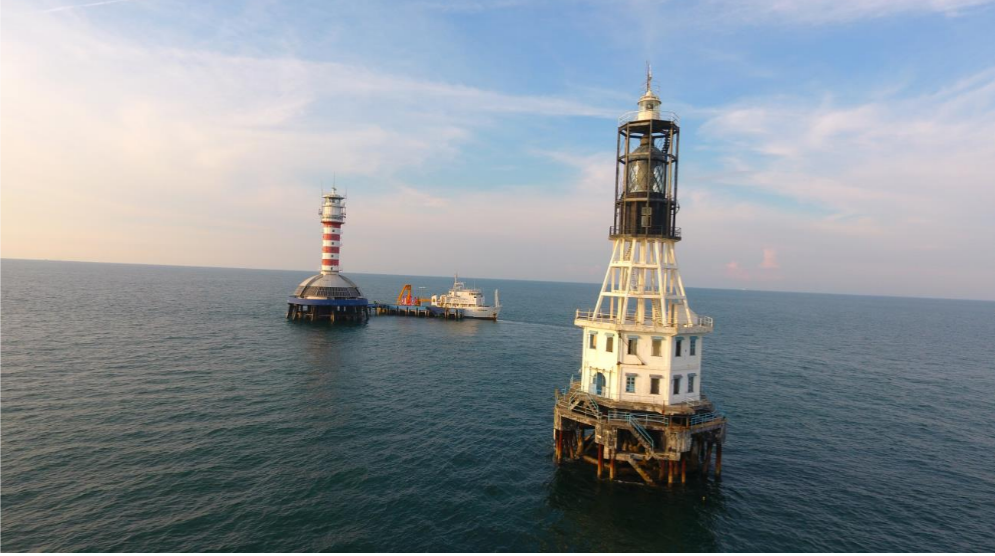One Fathom Bank Lighthouse modernisation
Ministry of Transport Malaysia and Malaysia Marine Department
Position
The One Fathom Bank Lighthouse, known in Malay as Rumah Api Permatang Sedepa, is a crucial maritime aid to navigation situated in the Strait of Malacca.
Positioned approximately 30 kilometres southwest of Klang, Selangor. This lighthouse has played an essential role in ensuring maritime safety for vessels navigating one of the busiest shipping lanes in the world. Over the years, the
lighthouse has undergone multiple upgrades, technological advancements, and structural transformations, reflecting Malaysia’s commitment to maritime safety and modernization.
The One Fathom Bank Lighthouse remains a critical maritime asset, playing an indispensable role in navigation safety along the Strait of Malacca. Its significance can be summarized as follows:
Ensures Safe Navigation: The lighthouse guides thousands of vessels passing through one of the world’s busiest shipping lanes, helping to prevent collisions and maritime accidents.
Marks Malaysia’s Maritime Territory: The lighthouse serves as a territorial marker, reinforcing Malaysia’s sovereignty in its exclusive economic zone (EEZ).
History
The One Fathom Bank Lighthouse has undergone several reconstructions and enhancements since its initial establishment, each phase marking a significant technological leap in maritime navigation.
The First Lighthouse (1852): The original structure
Constructed by the British colonial administration in 1852, following the identification of the shallow sandbank by British hydrographer John Turnbull Thomson. Built as a screw-pile lighthouse, a common design for lighthouses in shallow waters, providing basic navigational guidance to vessels.
The Second Lighthouse (1874): Introduction of the Fresnel lens
In 1874, the first lighthouse was replaced with a more advanced structure, featuring a first-generation Fresnel lens. This upgrade significantly improved light intensity and range, making it more effective for navigation.
The Third Lighthouse (1907): Reinforced concrete structure
A stronger, octagonal concrete-pile lighthouse was constructed in 1907, replacing the older structure. The Fresnel lens system from the previous lighthouse was retained until 1973, when it was upgraded to an electric light system using a 500W halogen bulb with a parabolic reflector, improving visibility and efficiency. This lighthouse served for nearly a century before being decommissioned in 1999.
The Fourth Lighthouse (1999 – Present): The modern lighthouse
The current One Fathom Bank Lighthouse was built in 1999, approximately 500 metres from the previous lighthouse. Standing at 43 metres (141 feet) tall, it was equipped with a PAR 56 Seal Beam 300W bulb, offering improved illumination and energy efficiency. The previous lighthouse was preserved as a historical structure.
MODERNIZATION AND AUTOMATION OF THE LIGHT SOURCE
Since its reconstruction in 1999, the One Fathom Bank Lighthouse has undergone several technological enhancements to improve efficiency, sustainability, and navigational capabilities.
Evolution of navigation light technology
The lighthouse has seen multiple upgrades in its light source technology to keep up with advancements in maritime navigation:
Year upgrades
1999 Installed PAR 56 Seal Beam 300W bulb.
2015 Upgraded to 1st Generation LED light source (PAR 65), offering greater
energy efficiency and longevity.
2020 Introduced 2nd Generation LED light source (MK2000), further enhancing
illumination range and reducing maintenance needs.
2024 The latest 3rd Generation LED light source was installed, providing
maximum brightness, lower power consumption, and improved durability
Power supply and automation
The lighthouse operates on a hybrid power system, which includes three diesel generators (100kVA each), operating on a rotational basis every eight hours to ensure an uninterrupted power supply. With A 24000-litrer fuel tank, providing extended operational capacity. The navigation light system is fully automated, reducing the need for manual operation.
Features of the modern lighthouse
Advanced navigation features
Radar Beacon (RACON): Equipped with a RACON system emitting Morse code “O” (Oscar), allowing ships to detect and identify the lighthouse on radar screens.
AIS RMS System (Installed in 2004): The Automatic Identification System (AIS) Remote Monitoring System (RMS) enables real-time monitoring of the lighthouse’s operational status.
Enhanced reflector design: The parabolic reflector was expanded to eliminate shadow effects, ensuring a continuous light beam.
Visibility range: The lighthouse’s signal can be seen up to 23 nautical miles, depending on weather conditions and sea surface reflection.
Structural and safety enhancements
Triple Balcony Tower Design: The lighthouse has a cylindrical steel tower with three balconies, supported by a dome-shaped base that houses essential facilities.
Fire safety measures: Equipped with CO2 fire extinguishers to manage fire hazards.
Climate control system: Air-conditioning units have been installed to provide a comfortable environment for the lighthouse keepers.
Lighthouse operations and maintenance
Lighthouse keepers and rotational duty system
Despite automation, the lighthouse requires human oversight. Two lighthouse keepers are stationed at the facility, working on a weekly rotational system, where they switch duties at the start of every week.
Their responsibilities include:
- Monitoring and maintaining power generators.
- Inspecting navigation light functionality.
- Ensuring fuel supply levels remain adequate.
- Conducting routine structural maintenance.
- Preservation of the Old Lighthouse
Though decommissioned in 1999, the old One Fathom Bank Lighthouse remains an historical maritime landmark.
In December 2003, a 16-month restoration project was undertaken at a cost of RM3.4 million, with contributions from the Marine Department, the Museum and Antiquities Department, and the Public Works Department.
The restoration aimed to preserve the structure as a heritage site, showcasing Malaysia’s maritime history.
Editorial note:
Text based on material kindly provided by the Ministry of Transport Malaysia and the Malaysia Marine Department.

